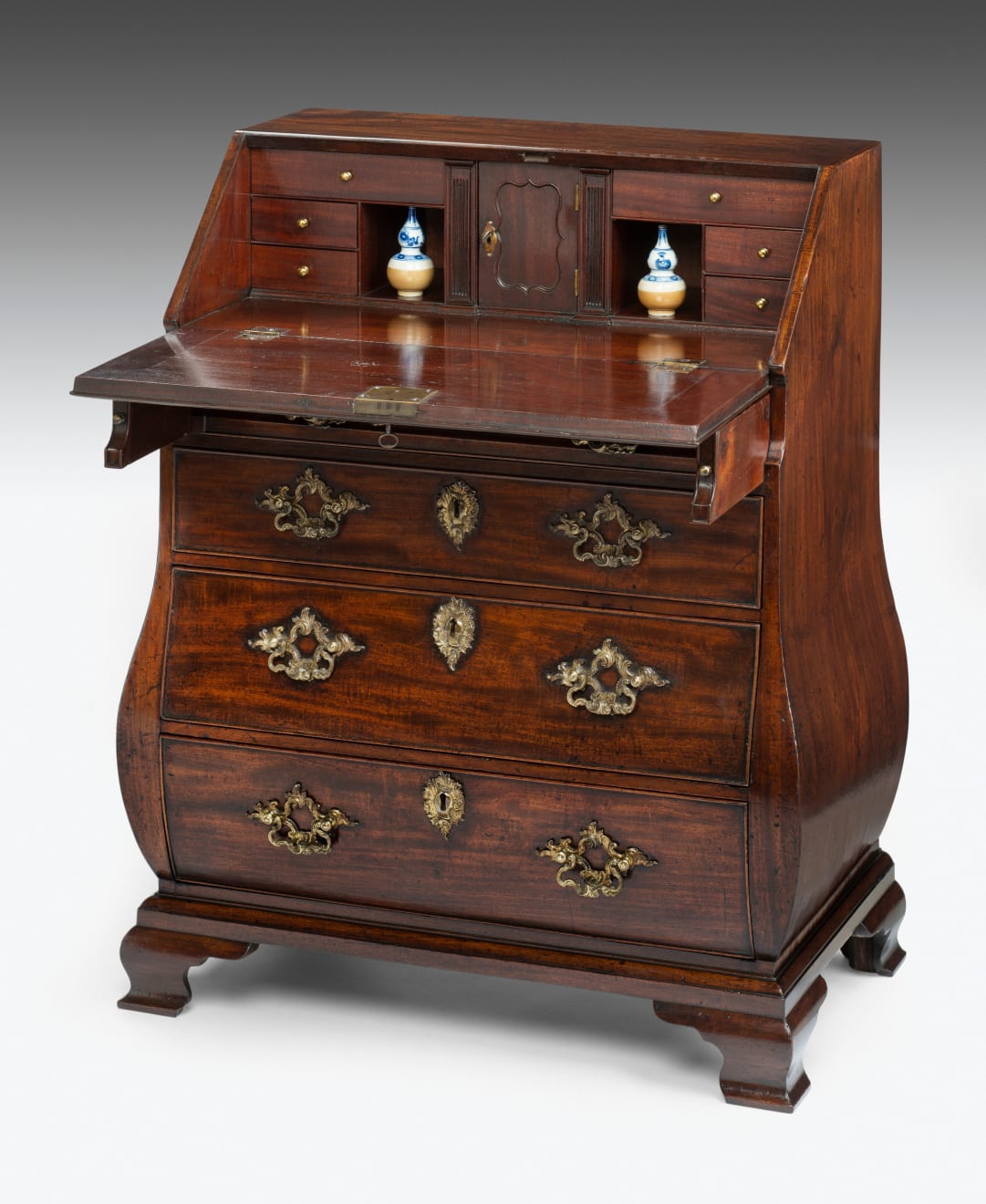George II Mahogany Bureau, in the manner of Giles Grendey, ex Percival Griffiths Collection
ENGLAND, CIRCA 1740
36 3/8 x 27 x 17 7/8 in
92.5 x 68.5 x 45.5 cm
92.5 x 68.5 x 45.5 cm
6980
Further images
Provenance
Percival D. Griffiths Collection, Sandridgebury, St Albans, Hertfordshire by 1918.
Keyman Antiques, New York, by 1969,
Jeremy Ltd., London, January 1970
Michael Bucks Esq.
Literature
H. Avray Tipping, English Furniture of the Cabriole Period (1700-1760). I- Drawer-Fitted Furniture, The Burlington Magazine for Connoisseurs 32, no. 183 (1918): p. 228–34 illustrated plate c.
H. Avray Tipping, English Furniture of the Cabriole Period, Jonathan Cape, 1922, illustrated plate 3
Christian Jussel and William DeGregorio, English Furniture 1680-1760 The Percival D. Griffiths Collection, Volume I, Yale University Press, New Haven and London, and The Crab Tree Farm Foundation, 2023, cat. no. F34, illustrated p. 81
Of bombé form and small proportions, the fall revealing a fitted interior comprising an arrangement of drawers and pigeon holes centred by cupboard door with cartouche-shaped panel flanked by fluted...
Of bombé form and small proportions, the fall revealing a
fitted interior comprising an arrangement of drawers and pigeon holes centred
by cupboard door with cartouche-shaped panel flanked by fluted pilasters.
The bombé-shaped carcass with graduated mahogany-lined drawers, the top drawer
with writing slide. Original ogee bracket feet and ornate cast gilt brass
handles. Brushing slide within upper drawer restored.
The cartouche-shaped frame of the interior central door echoes designs by Giles Grendey (1693-1780). A mahogany linen press by Grendey, c. 1745 with similar cartouche doors is illustrated in the Pictorial Dictionary of Marked London Furniture, 1700-1840 by Christopher Gilbert (Furniture History Society, 1996), p. 241 pl. 433.
The distinctive door design is also found in a George II burr walnut bureau cabinet circa 1740 (hammer price £240,000) sold at Sotheby's on 5th June 2007. Both the cabinet and interior door of the bureau is of similar form and the elaborate drawer handles are identical.
The Dictionary of English Furniture describes the bombé shape of such bureaux, which are curved to the front and sides, as 'borrowed from Holland' (p. 134 and see Fig. 30 for a bureau cabinet with a lower section of comparable form). It is rare to find such an early example of the form, particularly of such diminutive proportions, made in England. The combination of the bombé form, the use of the mahogany linings in the drawers and the elaborate gilt brass escutcheons and handles certainly point to a leading London cabinet maker.
Percival D. Griffiths (1862–1937): lived at Sandridgebury, St. Albans, Hertfordshire and formed a collection of English furniture dating from the late 17th and early 18th centuries under the guidance of English furniture historian R.W. Symonds. His collection was considered one of the finest ever assembled. In the Foreword to 'English Furniture from Charles II to George II' by Symonds (1929), which included over 260 illustrations of his pieces, Griffiths wrote of his approach to collecting: 'what I have done is to buy pieces of antique furniture which appealed to me as fine examples, and not allowed my choice to be influenced by pieces that happened to fulfil any required utilitarian purpose.'
The collection was sold at Christies in 1939 after Griffiths died while hunting with the Whaddon Chase on 11th December, 1937. Many pieces now reside in museums, including scores of items in the Metropolitan Museum of Art, New York and several in the Victoria and Albert Museum.
fitted interior comprising an arrangement of drawers and pigeon holes centred
by cupboard door with cartouche-shaped panel flanked by fluted pilasters.
The bombé-shaped carcass with graduated mahogany-lined drawers, the top drawer
with writing slide. Original ogee bracket feet and ornate cast gilt brass
handles. Brushing slide within upper drawer restored.
The cartouche-shaped frame of the interior central door echoes designs by Giles Grendey (1693-1780). A mahogany linen press by Grendey, c. 1745 with similar cartouche doors is illustrated in the Pictorial Dictionary of Marked London Furniture, 1700-1840 by Christopher Gilbert (Furniture History Society, 1996), p. 241 pl. 433.
The distinctive door design is also found in a George II burr walnut bureau cabinet circa 1740 (hammer price £240,000) sold at Sotheby's on 5th June 2007. Both the cabinet and interior door of the bureau is of similar form and the elaborate drawer handles are identical.
The Dictionary of English Furniture describes the bombé shape of such bureaux, which are curved to the front and sides, as 'borrowed from Holland' (p. 134 and see Fig. 30 for a bureau cabinet with a lower section of comparable form). It is rare to find such an early example of the form, particularly of such diminutive proportions, made in England. The combination of the bombé form, the use of the mahogany linings in the drawers and the elaborate gilt brass escutcheons and handles certainly point to a leading London cabinet maker.
Percival D. Griffiths (1862–1937): lived at Sandridgebury, St. Albans, Hertfordshire and formed a collection of English furniture dating from the late 17th and early 18th centuries under the guidance of English furniture historian R.W. Symonds. His collection was considered one of the finest ever assembled. In the Foreword to 'English Furniture from Charles II to George II' by Symonds (1929), which included over 260 illustrations of his pieces, Griffiths wrote of his approach to collecting: 'what I have done is to buy pieces of antique furniture which appealed to me as fine examples, and not allowed my choice to be influenced by pieces that happened to fulfil any required utilitarian purpose.'
The collection was sold at Christies in 1939 after Griffiths died while hunting with the Whaddon Chase on 11th December, 1937. Many pieces now reside in museums, including scores of items in the Metropolitan Museum of Art, New York and several in the Victoria and Albert Museum.










